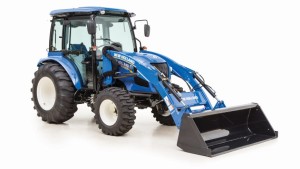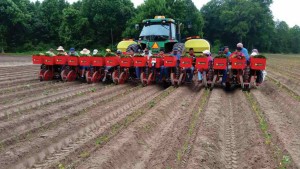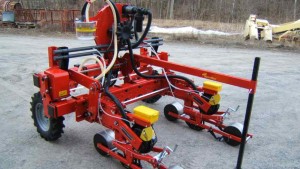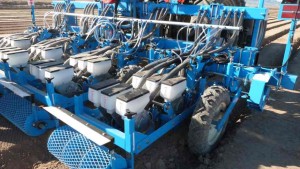Tractors & Planters: Maximum Reliability Required
Controlling labor costs. Decreasing downtime. Ease of use. Those are just a few of the criteria you want in your tractor or planter.
You need equipment that will be efficient, high-quality, and reliable. You want it to be more like you — to be able to multitask.
I had a chance to catch up with several manufacturers and suppliers of tractors and planters to find out how they are adapting their respective product lines to meet your needs.
Multitasking Tractors
Tractors that can handle many operations on the farm always are in demand. Todd DeBock, Marketing Manager at New Holland Corporate of North America, says tractors that can multitask are what growers, particularly ones on the smaller end of the spectrum, need the most.
The equipment must help with tillage, secondary tillage, seeding, transplanting, cultivation, and specialty implements. Plus, he says, the unit must allow quick and easy changes between different attachments.
Sustainable Solutions

Boomer models 37, 41, or 47 from New Holland with Tier 4B Final compliant engines feature a 3-point hitch with flexible link ends and a telescopic stabilizer for easy implement hookup and quick changeover.
As sustainability is key for growers, having equipment that is environmentally friendly is another factor to consider when making purchasing decisions.
“From a sustainability standpoint, growers are looking for equipment that has a small environmental footprint,” DeBock says. “And with most customers today, reliability is top of mind — a tractor that provides maximum uptime.”
At New Holland, DeBock says creating more efficient engines has been on the front burner. Making sure its tractors are in compliance with EPA emission standards, the company launched its first Tier 4B compliant tractor in 2014. Specifically, he says the Tier 4B final compliant engines are more powerful and use less fuel, making them more environmentally friendly.
Chris Lammie, Product Manager, John Deere Commercial Products, agrees fuel usage is a big grower consideration. The company currently offers features such as economy PTO for reduced fuel consumption, which is standard on its 5MH tractors.
And they’re not stopping there. Lammie says growers are aksing for featurs from tractors that use bio-hydraulic fluid for environmentally sensitive areas all the way to technology capable of documenting chemicals applied and weather conditions.
In John Deere’s latest product update, he says the focus has been on technology related to operator comfort. Specifically, the goal was to make long hours in the field more comfortable.
“The high-back, low-frequency air suspension seat has been a big improvement in comfort for operators,” he says. “The cab with sound has been very popular. These all are technology features aimed at keeping a grower’s operators comfortable for all-day work.”
Tractor Choice And Farm Size
As you’d expect, farm size determines which tractor you are going to use. However, Lammie says some large farms also may have smaller fields that require the use of a compact tractor.
DeBock agrees farm size can impact the type and number of tractors used as well as the size of implements needed. Specifically, he says depending on the scale of operation, growers might need anything from a compact tractor all the way to an articulated front-wheel drive.
For example, a 25-acre farm would likely employ a utility tractor (about 75 horsepower) for primary tillage while using a smaller compact tractor for seeding, transplanting etc., he says.
Equipment Of The Future

The 5100MH from John Deere is designed for customers with crop clearance and row spacing requirements.
As modern technology continues to advance, Lammie says we will continue to see more vegetable growers adopt guidance solutions.
“The tractor of the future will likely have more integration with precision technologies,” he explains. “[We will also] probably see more creature comforts around technology as well. We know that many operators stream music while operating the tractor using our Bluetooth-enabled radio. Perhaps future connectivity enhancements will make it even easier to spend long days in the seat of the tractor.”
Having some of the technology used on large tractors available on small, compact tractors — while keeping the tractor operation simple — also will be something to look forward to down the line, DeBock adds. Some of that technology includes programmability related to engine management, alternate fuel capability, and more advanced hydraulics — just to name a few.
Planters: Make Every Seed Count
In the planting arena, growers’ needs are similar to what they are looking for in tractors: ease of use, increased efficiency, and a reduction in labor. They also want to make every seed count.
According to Ross Ayler, Territory Sales Manager at Monosem, however, different plant-ers are needed, depending on the size of the operation.
“Small- to medium-sized farms producing a wide variety of vegetable crops are interested in a single planter that can plant all of their seeds,” he says. “Large-scale farms tend to purchase more than one planter, each configured to a specific crop or row spacing configuration.”
Ride The Technology Wave
As technology is always changing, equipment manufacturers must stay abreast of the changes and present the latest advancements to customers in a way they will understand and be able to evaluate on their farms.
“A lot of the features like seed and liquid monitoring systems are sophisticated, and growers need to know how to make adjustments in real time,” explains Greg Spooner, CFO of Specialty Sales Co., the supplier of the drum punch planter. “(The grower needs to) get that information as he is going down the row, so he can make decisions based on the feedback he receives on the monitor.”
At Monosem, Ayler says the company has developed sync-row technology, which permits staggering the seeds between seed lines. This technology has recently been integrated into Monosem’s MS-Mini Seed planters.
“New technology that improves seed placement, depth control, down-pressure control, and planter monitoring are valuable to growers looking to improve production and efficiency,” he adds.
Technology also helps with labor reduction. Citing C&M’s Dual 12 Gold transplanter model as an example, Grant Allen of Allen International, the North American representative of Italy-based Checchi & Magli (C&M), points out that one person can set two rows from a 12-cup carousel, which works out to 5,500 to 6,500 plants per hour.
Putting a dollar figure on the labor savings, Frank Ferris of Ferris Farms, the manufacturer of the Polyplanter, says a one- to three-row unit planting under plastic can save growers from $200 to $700 per acre. Ferris’ Polyplanter is currently used by growers producing on 50 to 1,000 acres.
“When you get down to it, the biggest benefit (of the Polyplanter) has been the vacuum unit to give you better singulation,” Ferris says. “Plus, it is important to keep it simple. Only one person is needed to run the planter. That is all it takes: one person and a tractor.”
A Sustainable Future
Noting the need for sustainability, Spooner says proper seed bed preparation and optimum seed placement in an efficient, streamlined process is the place to start. Spooner predicts that in the future, we will be able to regulate seed populations and narrow our focus on the placement of other inputs.
“Today, we are able to upload prescription maps and the planter can make changes to the seeding rate autonomously,” he explains. “In the future, we also will be able to directly inject a prescribed blend of fertilizer, fungicide, and/or insecticide according to the needs of the seed in a particular location. This technology will cut input cost because we will look at the exact needs of individual plants, not the needs of broad acres.”
The Transplant Movement

This eight-row Foxdrive transplanter from Checchi & Magli is planting sweet potatoes. The transplatner is a modular design and each transplatner unit is mounted on a tool bar.
Photo courtesy of Grant Allen, Allen International
Grant Allen of Allen International, the North American representative of Italy-based Checchi & Magli (C&M), says more transplanting is taking place than ever before because farmers are finding they can go to market sooner, as well as have less overall crop loss.
In particular, for the markets he serves in North America and especially in the Southeast, Allen is seeing a surge in sweet potato production in North Carolina. In the last few years, he says, sweet potato numbers have gone from 60,000 acres to more than 100,000 acres in 2015.
Why the increase? He says consumption is on the rise, thanks to the noted health benefits of sweet potatoes — a good source of beta-carotene and Vitamin A — and the popularity of sweet potato fries.
Allen says sweet potatoes always have been a crop that is transplanted using “slips,” which are shoots from a mature sweet potato.
“What farmers like about our transplanting machines is they plant at a deep and a consistent speed,” he says. “Plus the weight of the operators on the machine has no impact on the planting of the crop. We also use a parallelogram, which provides a more consistent depth of control. In addition, our packing wheels pack and our drive wheels drive, allowing the slip to plant deep and stand straight.”
In addition to North Carolina, Allen is seeing similar trends in sweet potato production in Mississippi, Georgia, Alabama, Florida, and California.
Options In Planting
Looking for planting equipment? Check out the offerings from some planter suppliers. Here are a few options in planting that may fit your farm’s needs.
Market Farm Implement: VegiMacc
 The VegiMacc from Market Farm Implement plants any size seed from carrot to pumpkin, has an easy set toolbar system to quickly change row spacings, and plants almost every seed in the chamber. It also is easy to clean seed out with the vacuum seed clean-out system.
The VegiMacc from Market Farm Implement plants any size seed from carrot to pumpkin, has an easy set toolbar system to quickly change row spacings, and plants almost every seed in the chamber. It also is easy to clean seed out with the vacuum seed clean-out system.
MarketFarm.com
Monosem: Version M
 Monosem’s latest planter model is the Version M mini-seed planter, which is capable of planting multiple lines as close as 1 inch apart across any bed width. The sync-row option is available for this planter for crops where it is beneficial to produce consistent-sized produce.
Monosem’s latest planter model is the Version M mini-seed planter, which is capable of planting multiple lines as close as 1 inch apart across any bed width. The sync-row option is available for this planter for crops where it is beneficial to produce consistent-sized produce.
Monosem-inc.com
Stanhay: Nine
Evolved from a metering unit is Stanhay Webb Ltd.’s new Nine planter. The machine, available from Solex, is designed to improve uniformity of seed spacing, driving each metering unit with an electric motor and synchronizing the seeds from line to line. This electronic control also makes set-up simpler and faster and can be done from a touch-screen terminal.
SolexCorp.com










